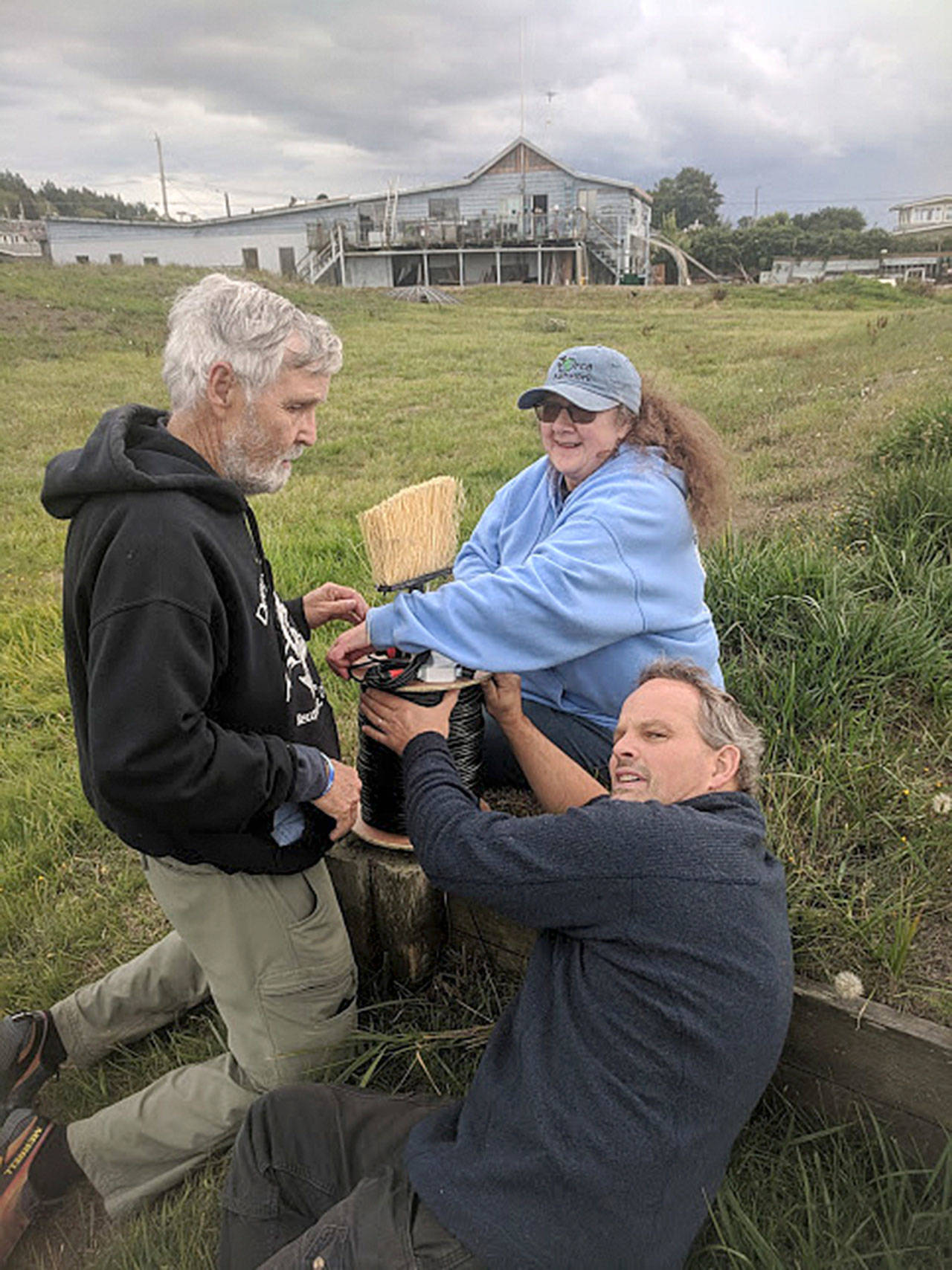Most of the time, it sounds like the white noise soundtrack of sleep.
Or perhaps the static of a faraway radio signal.
But every once in awhile, Whidbey Island’s new ear to the ocean will catch the squeals of orcas and the man-made noises that might be harming them.
Called a hydrophone, the underwater microphone just launched by Orca Network at Bush Point, projects 10 miles into Admiralty Inlet from the southwest shoreline of Whidbey. There, strong Pacific tides rush to and from Puget Sound and mix with rivers, attracting a rich variety of marine life and sea birds.
It’s hoped the hydrophone will help augment on-going research about the seasonal migration of salmon and the movement of the local three pods of southern resident killer whales, said Orca Network co-founders Susan Berta and Howard Garrett.
The whale pods, known as J, K and L, are struggling to survive. Numbering nearly 100 in 1995, the population has dwindled to 74. The whales are threatened by toxins, ship traffic and a lack of food, specifically chinook salmon, according to the Center for Whale Research.
The research-quality hydrophone will allow scientists to study the effects of ocean noise and measure the levels of sound generated by ships passing by.
Southern resident orcas typically return to Puget Sound in the fall, following chum salmon that have returned to spawn, Berta said.
“People interested in orcas can now listen to them, as well as see them,” she said.
But the equipment has a few kinks to work out.
“Unfortunately, the hydrophone went down, except for occasional sporadic bursts for a few seconds at a time, since we sent out the Nov. 1 press release and J pod came down Admiralty,” Garrett said. “The techies are on the case, and their diagnosis is that there’s a power supply problem, which can be fixed.”
To install the sound device, the Orca Network of Langley partnered with Beam Reach/OrcaSound and the Center for Whale Research that coordinates a network of hydrophones around the Salish Sea.
The Bush Point hydrophone is part of the new OrcaSound App, which includes underwater mics near San Juan Island; another may be added near Langley. It can be accessed on smart phones and allows an unlimited number of people to dip their ear in the ocean without getting wet.
“The (audio) stream is currently being archived on Amazon servers, and for research nodes we will also archive higher-resolution audio data,” said Scott Veirs, oceanographer, bioacoustician and founder of Beam Reach/OrcaSound.
OrcaSound’s website encourages listeners to become citizen scientists by reporting live orca sounds to a specified email address and to log observations on a spreadsheet.
During the summer months, southern resident orcas are usually heard every few days via hydrophone technology.
They emit a diverse repertoire of calls, or vocalizations, some 40 distinct signals within the hearing range of humans, according to Orca Network.
Typically, the southern resident orcas return in early October after spending the summer feeding on Fraser River chinook salmon runs in the San Juan and Canadian Gulf Islands, Georgia and Juan de Fuca Straits.
But Fraser River salmon stocks are still at record lows so J, K, and L pods had little food to bring or keep them inland, Berta said.
“So we are hoping there are enough fall chum salmon to bring them into Puget Sound,” she said. “Though J pod did make two quick appearances venturing into Puget Sound in September, they didn’t linger. And for the first time in several decades they did not make an appearance in Admiralty Inlet or Puget Sound during October.”
Orca recordings collected from more than 15 years of listening to the Salish Sea help scientists understand the distinct vocalizations of the southern resident pods and their migratory movements.
The public can also tune in to hear humpbacks whales, transient killer whales, harbor seals and a collection of other rare and unusual sounds, including fish farts, at the Langley Whale Center’s underwater listening exhibit.
This past March, hydrophones picked up the rare sound of a lone sperm whale. “The last time a sperm whale was heard even close to the Salish Sea was more than 30 years ago,” Veirs wrote on his OrcaSound blog. The largest of toothed whales, the sperm whale echolocation of loud clicks sounds like metal marbles being shot from a pellet gun.
The Bush Point hydrophone was built by Lab-Corp. Florian Graner, an underwater filmmaker and diver with SeaLife Productions, installed the device. Owners of Bush Point Bed and Breakfast agreed to wharf access and to have communications equipment installed in their building that connects to the underwater equipment; Whidbey Telecom provided a grant to fund high-speed Internet access. Kickstarter donations also support the project.
• Listen to whales at www.orcasound.net


